Strategy Management: IKEA Case Study Analysis Report
VerifiedAdded on 2023/01/16
|10
|2272
|72
Case Study
AI Summary
This case study examines IKEA's strategic management, focusing on its background, current strategy intent, and potential failures. It analyzes IKEA's marketing mix, value chain, and supply chain strategies, highlighting the company's focus on cost-effectiveness, environmental considerations, and global expansion through franchising and joint ventures. The analysis identifies shortcomings in data management, human resources, and customer relationship management. The study recommends implementing technology, improving employee welfare, enhancing product design, and promoting products through organized events and campaigns to address these issues and sustain growth. The report concludes by emphasizing the importance of adapting to future challenges and maintaining a competitive edge.
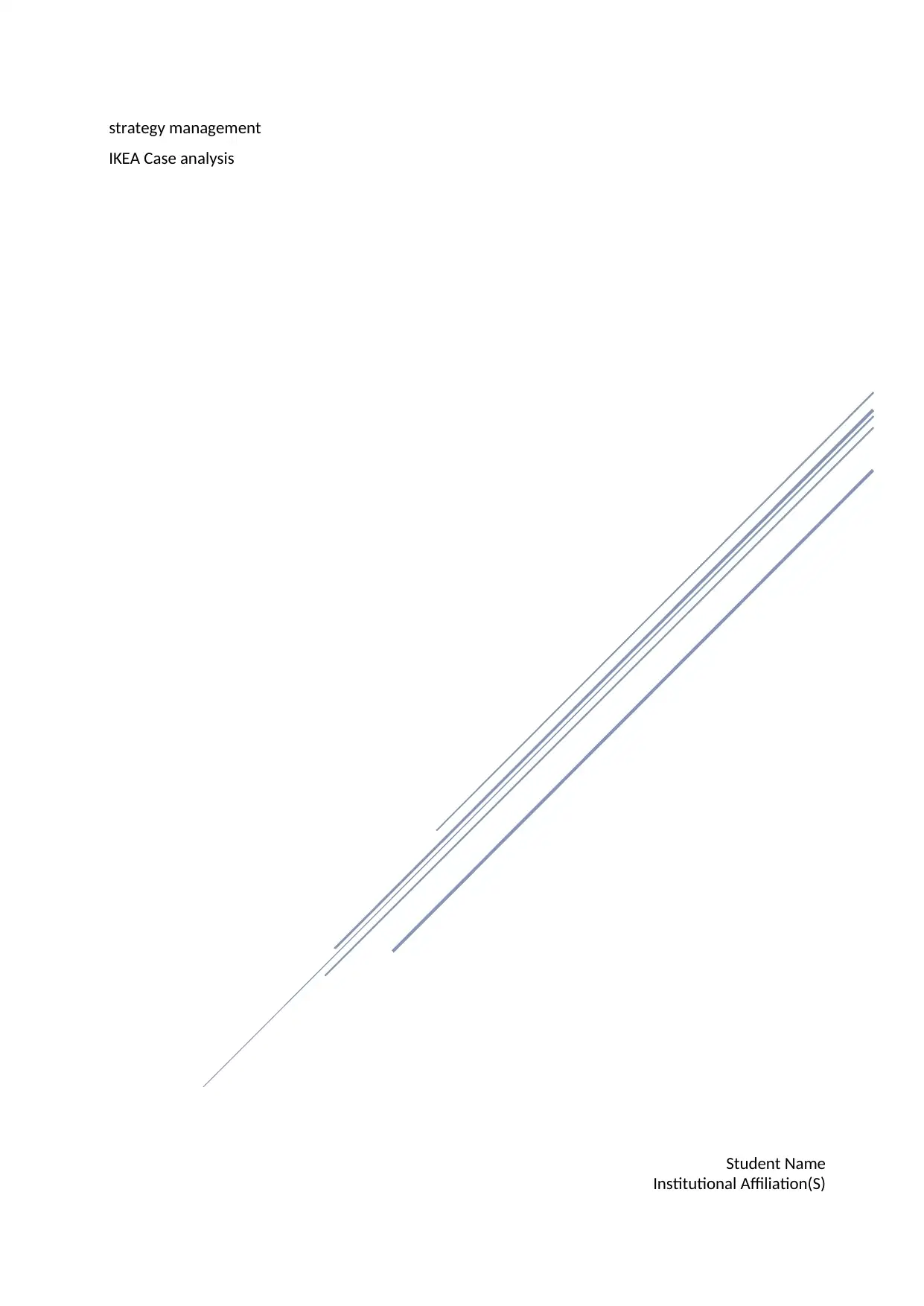
Student Name
Institutional Affiliation(S)
strategy management
IKEA Case analysis
Institutional Affiliation(S)
strategy management
IKEA Case analysis
Paraphrase This Document
Need a fresh take? Get an instant paraphrase of this document with our AI Paraphraser
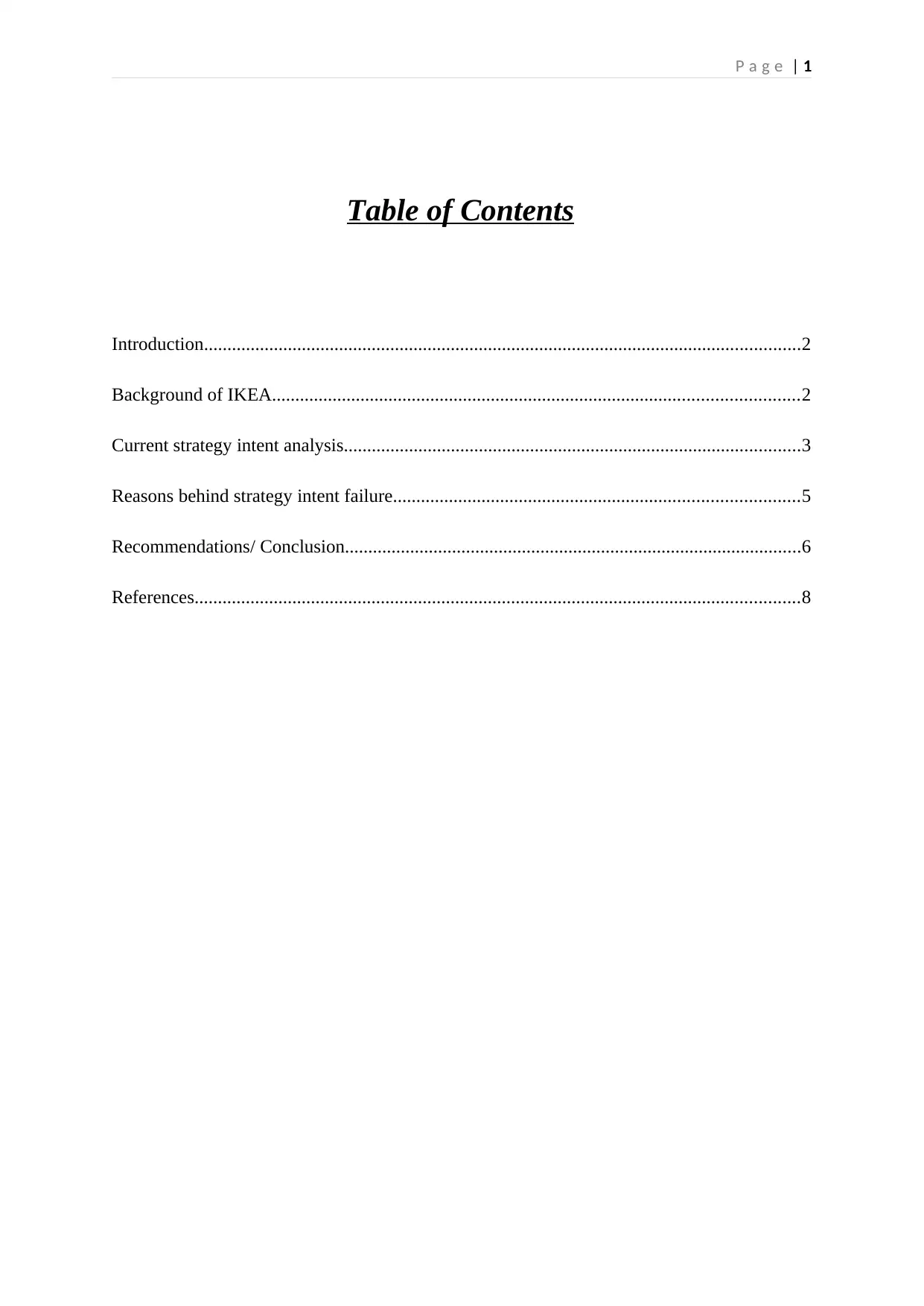
P a g e | 1
Table of Contents
Introduction................................................................................................................................2
Background of IKEA.................................................................................................................2
Current strategy intent analysis..................................................................................................3
Reasons behind strategy intent failure.......................................................................................5
Recommendations/ Conclusion..................................................................................................6
References..................................................................................................................................8
Table of Contents
Introduction................................................................................................................................2
Background of IKEA.................................................................................................................2
Current strategy intent analysis..................................................................................................3
Reasons behind strategy intent failure.......................................................................................5
Recommendations/ Conclusion..................................................................................................6
References..................................................................................................................................8

P a g e | 2
Introduction
An organisation is usually established after considering strategic goal achievement
and this goal further defines purpose for its strategic operations. According to Tapera (2014),
management of the firms formulates strategies mainly due to reasons like to proactively craft
business formulas about how business shall be carried and to assert a thoughtful strategy to
build a road map for gaining competitive position by pleasing consumers and financial
performance progresses. Indeed, review made by Athapaththu (2016) also signifies that
effective strategy formulation along with strategic management can bring positive impacts on
organisation’s return on investments, revenue growth and earning. The strategy planning
should be given critical thought over otherwise which issues flinches thereby hampering
overall organisational productivity. The basic intention behind preparing this report is to
analyse effectiveness of strategic management and current strategic intent of IKEA to find
out why this intent may be failing to make recommendations for selecting new and effective
strategy.
Background of IKEA
Founded in the year 1943, IKEA is one of the most successful company dealing in
furniture manufacturing and retail chain whose headquarters is situated in Sweden. According
to the media reports, IKEA is worldwide largest retailer dealing in modern and functional
furniture’s (Davies, 2013). The company focuses upon interior designing related works that
have helped it gain competitive position in its industry. Besides providing furniture in cost
effective prices, the products of the IKEA show stances of environmental considerations that
has made IKEA gain much reputation in international marketplace. IKEA always follows its
vision statement stating, “To create a better everyday life for the many people” (IKEA,
2019). The learning capability of the firm have made IKEA flourish in furniture market
where they always try to appreciate local taste to make furniture according to customers
Introduction
An organisation is usually established after considering strategic goal achievement
and this goal further defines purpose for its strategic operations. According to Tapera (2014),
management of the firms formulates strategies mainly due to reasons like to proactively craft
business formulas about how business shall be carried and to assert a thoughtful strategy to
build a road map for gaining competitive position by pleasing consumers and financial
performance progresses. Indeed, review made by Athapaththu (2016) also signifies that
effective strategy formulation along with strategic management can bring positive impacts on
organisation’s return on investments, revenue growth and earning. The strategy planning
should be given critical thought over otherwise which issues flinches thereby hampering
overall organisational productivity. The basic intention behind preparing this report is to
analyse effectiveness of strategic management and current strategic intent of IKEA to find
out why this intent may be failing to make recommendations for selecting new and effective
strategy.
Background of IKEA
Founded in the year 1943, IKEA is one of the most successful company dealing in
furniture manufacturing and retail chain whose headquarters is situated in Sweden. According
to the media reports, IKEA is worldwide largest retailer dealing in modern and functional
furniture’s (Davies, 2013). The company focuses upon interior designing related works that
have helped it gain competitive position in its industry. Besides providing furniture in cost
effective prices, the products of the IKEA show stances of environmental considerations that
has made IKEA gain much reputation in international marketplace. IKEA always follows its
vision statement stating, “To create a better everyday life for the many people” (IKEA,
2019). The learning capability of the firm have made IKEA flourish in furniture market
where they always try to appreciate local taste to make furniture according to customers
⊘ This is a preview!⊘
Do you want full access?
Subscribe today to unlock all pages.

Trusted by 1+ million students worldwide
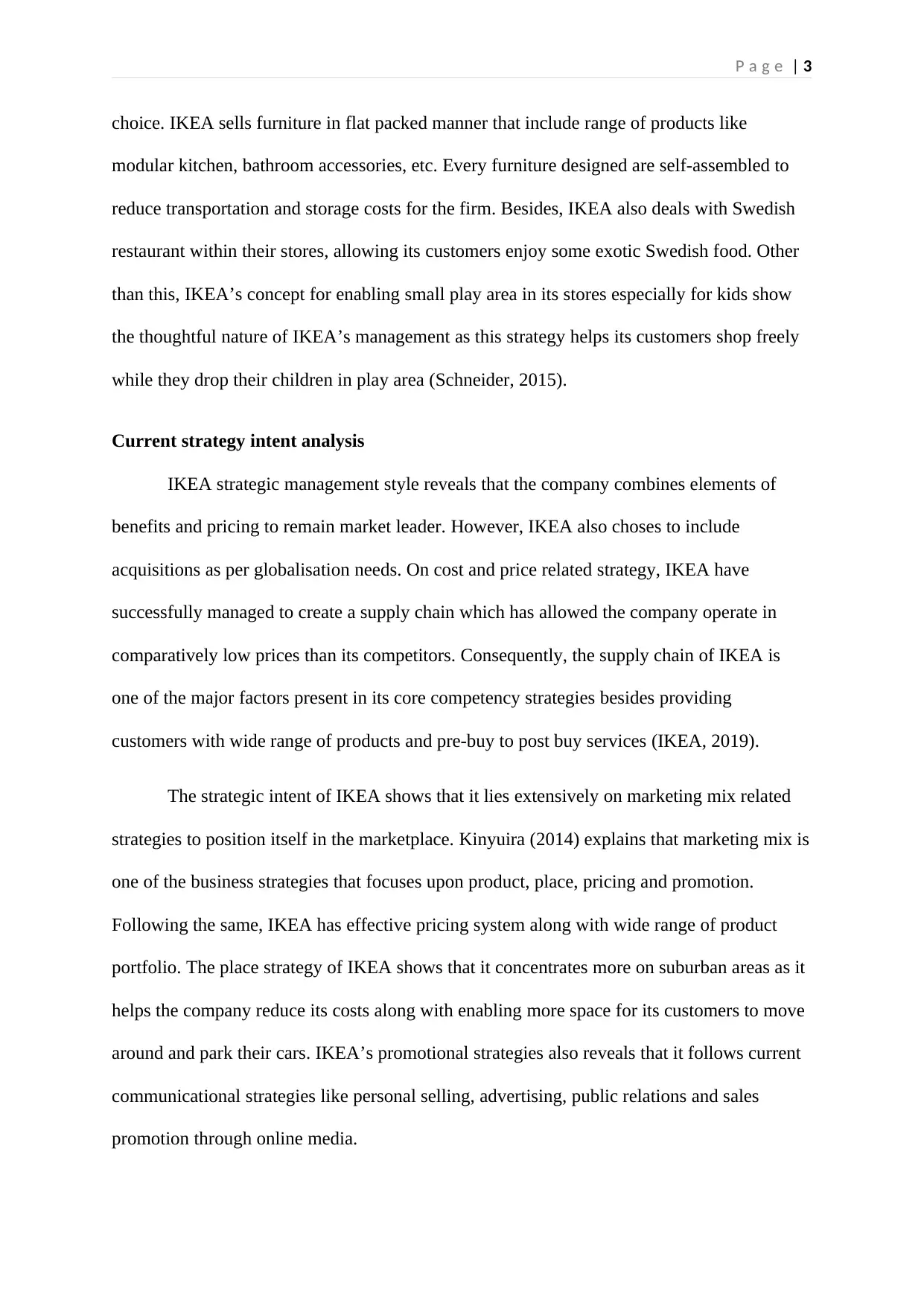
P a g e | 3
choice. IKEA sells furniture in flat packed manner that include range of products like
modular kitchen, bathroom accessories, etc. Every furniture designed are self-assembled to
reduce transportation and storage costs for the firm. Besides, IKEA also deals with Swedish
restaurant within their stores, allowing its customers enjoy some exotic Swedish food. Other
than this, IKEA’s concept for enabling small play area in its stores especially for kids show
the thoughtful nature of IKEA’s management as this strategy helps its customers shop freely
while they drop their children in play area (Schneider, 2015).
Current strategy intent analysis
IKEA strategic management style reveals that the company combines elements of
benefits and pricing to remain market leader. However, IKEA also choses to include
acquisitions as per globalisation needs. On cost and price related strategy, IKEA have
successfully managed to create a supply chain which has allowed the company operate in
comparatively low prices than its competitors. Consequently, the supply chain of IKEA is
one of the major factors present in its core competency strategies besides providing
customers with wide range of products and pre-buy to post buy services (IKEA, 2019).
The strategic intent of IKEA shows that it lies extensively on marketing mix related
strategies to position itself in the marketplace. Kinyuira (2014) explains that marketing mix is
one of the business strategies that focuses upon product, place, pricing and promotion.
Following the same, IKEA has effective pricing system along with wide range of product
portfolio. The place strategy of IKEA shows that it concentrates more on suburban areas as it
helps the company reduce its costs along with enabling more space for its customers to move
around and park their cars. IKEA’s promotional strategies also reveals that it follows current
communicational strategies like personal selling, advertising, public relations and sales
promotion through online media.
choice. IKEA sells furniture in flat packed manner that include range of products like
modular kitchen, bathroom accessories, etc. Every furniture designed are self-assembled to
reduce transportation and storage costs for the firm. Besides, IKEA also deals with Swedish
restaurant within their stores, allowing its customers enjoy some exotic Swedish food. Other
than this, IKEA’s concept for enabling small play area in its stores especially for kids show
the thoughtful nature of IKEA’s management as this strategy helps its customers shop freely
while they drop their children in play area (Schneider, 2015).
Current strategy intent analysis
IKEA strategic management style reveals that the company combines elements of
benefits and pricing to remain market leader. However, IKEA also choses to include
acquisitions as per globalisation needs. On cost and price related strategy, IKEA have
successfully managed to create a supply chain which has allowed the company operate in
comparatively low prices than its competitors. Consequently, the supply chain of IKEA is
one of the major factors present in its core competency strategies besides providing
customers with wide range of products and pre-buy to post buy services (IKEA, 2019).
The strategic intent of IKEA shows that it lies extensively on marketing mix related
strategies to position itself in the marketplace. Kinyuira (2014) explains that marketing mix is
one of the business strategies that focuses upon product, place, pricing and promotion.
Following the same, IKEA has effective pricing system along with wide range of product
portfolio. The place strategy of IKEA shows that it concentrates more on suburban areas as it
helps the company reduce its costs along with enabling more space for its customers to move
around and park their cars. IKEA’s promotional strategies also reveals that it follows current
communicational strategies like personal selling, advertising, public relations and sales
promotion through online media.
Paraphrase This Document
Need a fresh take? Get an instant paraphrase of this document with our AI Paraphraser
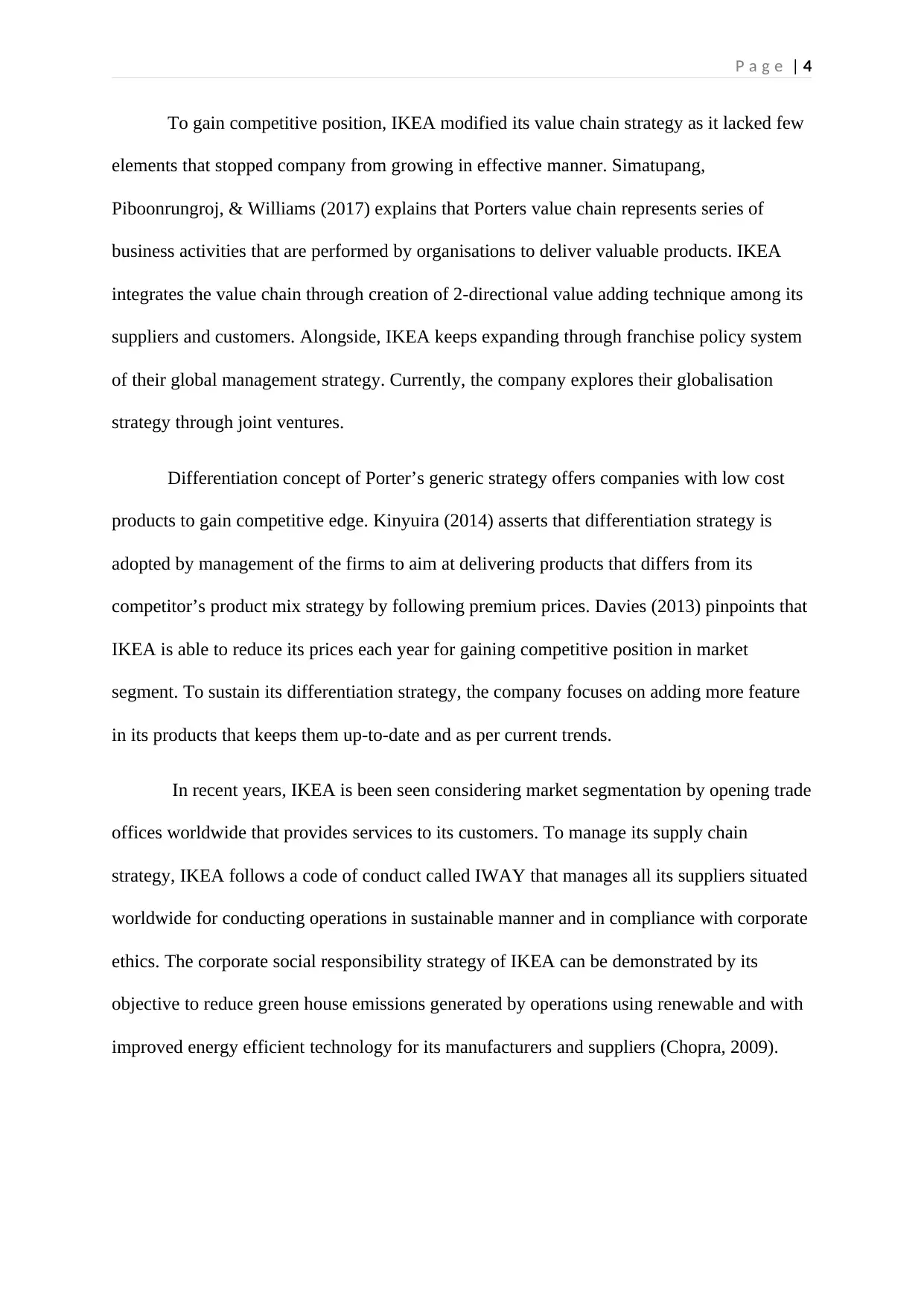
P a g e | 4
To gain competitive position, IKEA modified its value chain strategy as it lacked few
elements that stopped company from growing in effective manner. Simatupang,
Piboonrungroj, & Williams (2017) explains that Porters value chain represents series of
business activities that are performed by organisations to deliver valuable products. IKEA
integrates the value chain through creation of 2-directional value adding technique among its
suppliers and customers. Alongside, IKEA keeps expanding through franchise policy system
of their global management strategy. Currently, the company explores their globalisation
strategy through joint ventures.
Differentiation concept of Porter’s generic strategy offers companies with low cost
products to gain competitive edge. Kinyuira (2014) asserts that differentiation strategy is
adopted by management of the firms to aim at delivering products that differs from its
competitor’s product mix strategy by following premium prices. Davies (2013) pinpoints that
IKEA is able to reduce its prices each year for gaining competitive position in market
segment. To sustain its differentiation strategy, the company focuses on adding more feature
in its products that keeps them up-to-date and as per current trends.
In recent years, IKEA is been seen considering market segmentation by opening trade
offices worldwide that provides services to its customers. To manage its supply chain
strategy, IKEA follows a code of conduct called IWAY that manages all its suppliers situated
worldwide for conducting operations in sustainable manner and in compliance with corporate
ethics. The corporate social responsibility strategy of IKEA can be demonstrated by its
objective to reduce green house emissions generated by operations using renewable and with
improved energy efficient technology for its manufacturers and suppliers (Chopra, 2009).
To gain competitive position, IKEA modified its value chain strategy as it lacked few
elements that stopped company from growing in effective manner. Simatupang,
Piboonrungroj, & Williams (2017) explains that Porters value chain represents series of
business activities that are performed by organisations to deliver valuable products. IKEA
integrates the value chain through creation of 2-directional value adding technique among its
suppliers and customers. Alongside, IKEA keeps expanding through franchise policy system
of their global management strategy. Currently, the company explores their globalisation
strategy through joint ventures.
Differentiation concept of Porter’s generic strategy offers companies with low cost
products to gain competitive edge. Kinyuira (2014) asserts that differentiation strategy is
adopted by management of the firms to aim at delivering products that differs from its
competitor’s product mix strategy by following premium prices. Davies (2013) pinpoints that
IKEA is able to reduce its prices each year for gaining competitive position in market
segment. To sustain its differentiation strategy, the company focuses on adding more feature
in its products that keeps them up-to-date and as per current trends.
In recent years, IKEA is been seen considering market segmentation by opening trade
offices worldwide that provides services to its customers. To manage its supply chain
strategy, IKEA follows a code of conduct called IWAY that manages all its suppliers situated
worldwide for conducting operations in sustainable manner and in compliance with corporate
ethics. The corporate social responsibility strategy of IKEA can be demonstrated by its
objective to reduce green house emissions generated by operations using renewable and with
improved energy efficient technology for its manufacturers and suppliers (Chopra, 2009).
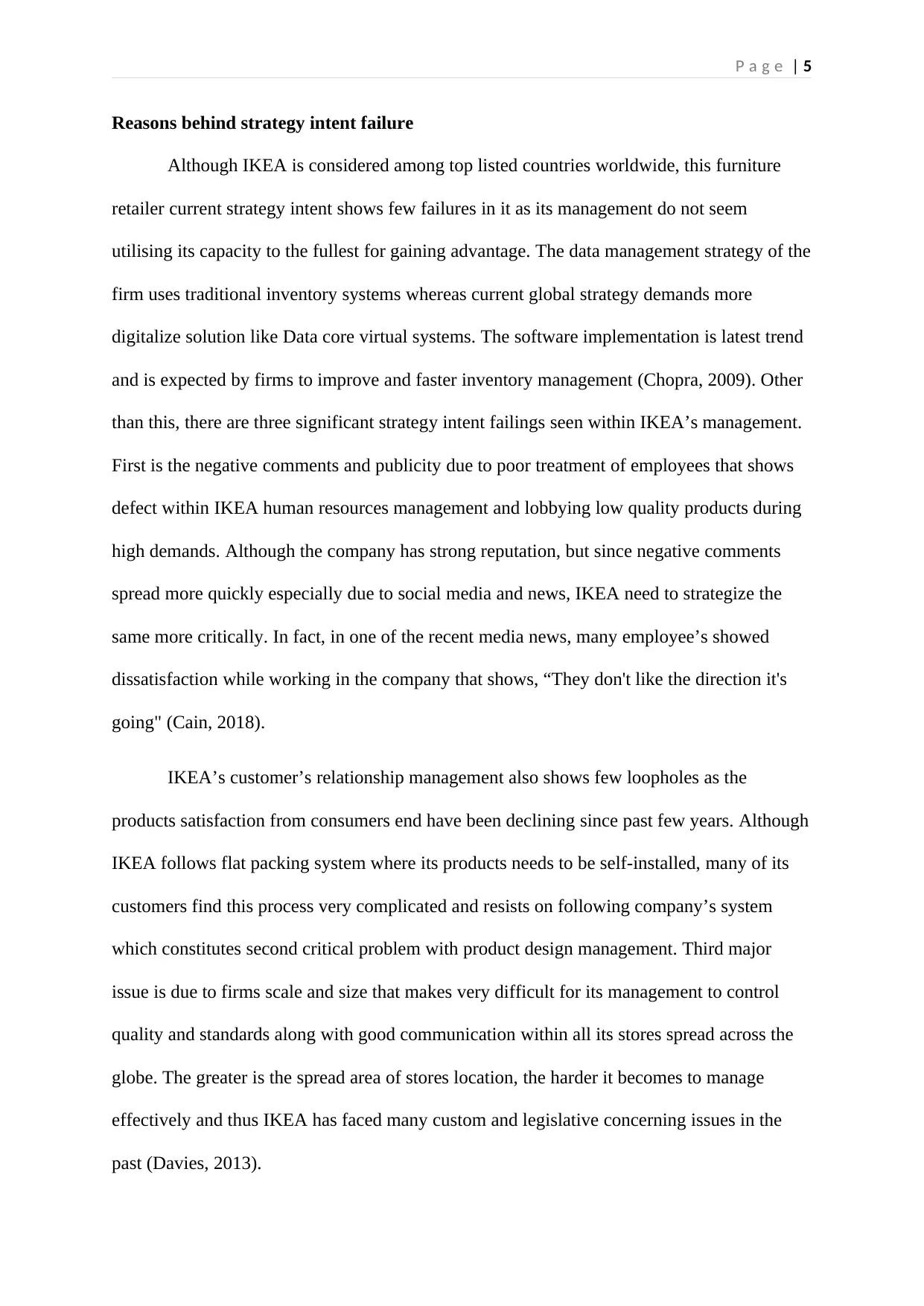
P a g e | 5
Reasons behind strategy intent failure
Although IKEA is considered among top listed countries worldwide, this furniture
retailer current strategy intent shows few failures in it as its management do not seem
utilising its capacity to the fullest for gaining advantage. The data management strategy of the
firm uses traditional inventory systems whereas current global strategy demands more
digitalize solution like Data core virtual systems. The software implementation is latest trend
and is expected by firms to improve and faster inventory management (Chopra, 2009). Other
than this, there are three significant strategy intent failings seen within IKEA’s management.
First is the negative comments and publicity due to poor treatment of employees that shows
defect within IKEA human resources management and lobbying low quality products during
high demands. Although the company has strong reputation, but since negative comments
spread more quickly especially due to social media and news, IKEA need to strategize the
same more critically. In fact, in one of the recent media news, many employee’s showed
dissatisfaction while working in the company that shows, “They don't like the direction it's
going" (Cain, 2018).
IKEA’s customer’s relationship management also shows few loopholes as the
products satisfaction from consumers end have been declining since past few years. Although
IKEA follows flat packing system where its products needs to be self-installed, many of its
customers find this process very complicated and resists on following company’s system
which constitutes second critical problem with product design management. Third major
issue is due to firms scale and size that makes very difficult for its management to control
quality and standards along with good communication within all its stores spread across the
globe. The greater is the spread area of stores location, the harder it becomes to manage
effectively and thus IKEA has faced many custom and legislative concerning issues in the
past (Davies, 2013).
Reasons behind strategy intent failure
Although IKEA is considered among top listed countries worldwide, this furniture
retailer current strategy intent shows few failures in it as its management do not seem
utilising its capacity to the fullest for gaining advantage. The data management strategy of the
firm uses traditional inventory systems whereas current global strategy demands more
digitalize solution like Data core virtual systems. The software implementation is latest trend
and is expected by firms to improve and faster inventory management (Chopra, 2009). Other
than this, there are three significant strategy intent failings seen within IKEA’s management.
First is the negative comments and publicity due to poor treatment of employees that shows
defect within IKEA human resources management and lobbying low quality products during
high demands. Although the company has strong reputation, but since negative comments
spread more quickly especially due to social media and news, IKEA need to strategize the
same more critically. In fact, in one of the recent media news, many employee’s showed
dissatisfaction while working in the company that shows, “They don't like the direction it's
going" (Cain, 2018).
IKEA’s customer’s relationship management also shows few loopholes as the
products satisfaction from consumers end have been declining since past few years. Although
IKEA follows flat packing system where its products needs to be self-installed, many of its
customers find this process very complicated and resists on following company’s system
which constitutes second critical problem with product design management. Third major
issue is due to firms scale and size that makes very difficult for its management to control
quality and standards along with good communication within all its stores spread across the
globe. The greater is the spread area of stores location, the harder it becomes to manage
effectively and thus IKEA has faced many custom and legislative concerning issues in the
past (Davies, 2013).
⊘ This is a preview!⊘
Do you want full access?
Subscribe today to unlock all pages.

Trusted by 1+ million students worldwide

P a g e | 6
Increase in globalisation of companies have also been challenging issue for the
IKEA’s management and to sustain, the firm needs to integrate their strategies after letting
independent business groups take their own managerial decisions which is currently
undertaken by firm’s management itself. This can create trouble for the company while
expanding its business along with facing crisis in future. Along with it, lack in technology
and innovation can be evaluated from company’s analysis. Since technology has increased
efficiency and convenience for sharing broad information, IKEA traditional management
style does not allow it to be more scalable, flexible and effectively operating with high stress
or within limited source environment (Schneider, 2015).
Recommendations/ Conclusion
The recent years have shown critical declination in IKEA’s growth majorly due to
strategy intent failing in few management areas of the firm. IKEA shows its pre-planned
approach along with alertness to market situation for avoiding unnecessary costs. However,
issues seen in its functional operation suggest company to take technical assistance by
implementing technology in its core business strategies. Even Pelser (2014) has cited that
current era of technology management goes far beyond expenditures, development and basic
research that have made many corporates undertake technology in their core operational
strategies.
IKEA’s human resources reflected strategy intent failings for which the company can
be recommended to consider strategic human resource management after considering
employee welfare and effective human capital management. IKEA can carry evaluation and
feedback system that will be influenced by factors like employee’s satisfaction level,
formulisation of evaluation, proper selection of individuals and availability of required data
to measure strategy intent failings in human resources area (Eneh & Awara, 2016).
Increase in globalisation of companies have also been challenging issue for the
IKEA’s management and to sustain, the firm needs to integrate their strategies after letting
independent business groups take their own managerial decisions which is currently
undertaken by firm’s management itself. This can create trouble for the company while
expanding its business along with facing crisis in future. Along with it, lack in technology
and innovation can be evaluated from company’s analysis. Since technology has increased
efficiency and convenience for sharing broad information, IKEA traditional management
style does not allow it to be more scalable, flexible and effectively operating with high stress
or within limited source environment (Schneider, 2015).
Recommendations/ Conclusion
The recent years have shown critical declination in IKEA’s growth majorly due to
strategy intent failing in few management areas of the firm. IKEA shows its pre-planned
approach along with alertness to market situation for avoiding unnecessary costs. However,
issues seen in its functional operation suggest company to take technical assistance by
implementing technology in its core business strategies. Even Pelser (2014) has cited that
current era of technology management goes far beyond expenditures, development and basic
research that have made many corporates undertake technology in their core operational
strategies.
IKEA’s human resources reflected strategy intent failings for which the company can
be recommended to consider strategic human resource management after considering
employee welfare and effective human capital management. IKEA can carry evaluation and
feedback system that will be influenced by factors like employee’s satisfaction level,
formulisation of evaluation, proper selection of individuals and availability of required data
to measure strategy intent failings in human resources area (Eneh & Awara, 2016).
Paraphrase This Document
Need a fresh take? Get an instant paraphrase of this document with our AI Paraphraser

P a g e | 7
Soliman (2011) said that to remain competitive, firms need to maintain their
customers satisfaction level along with building positive relationship with them. Since IKEA
show strategy failing intent while providing complex products that makes its customer face
troubles, IKEA can strategize its product designing system in more user-friendly way or can
allot special teams who will be responsible for assembling products for their customers who
faces trouble while assembling the furniture by themselves. Apart from the above
recommendations, IKEA needs to be ready for future consequences to remain successful and
thus requires promoting their products in more organised way through events and campaigns
which will not only make IKEA’s brand more popular, but also let people know how
functional and cost-effective their products are.
Soliman (2011) said that to remain competitive, firms need to maintain their
customers satisfaction level along with building positive relationship with them. Since IKEA
show strategy failing intent while providing complex products that makes its customer face
troubles, IKEA can strategize its product designing system in more user-friendly way or can
allot special teams who will be responsible for assembling products for their customers who
faces trouble while assembling the furniture by themselves. Apart from the above
recommendations, IKEA needs to be ready for future consequences to remain successful and
thus requires promoting their products in more organised way through events and campaigns
which will not only make IKEA’s brand more popular, but also let people know how
functional and cost-effective their products are.
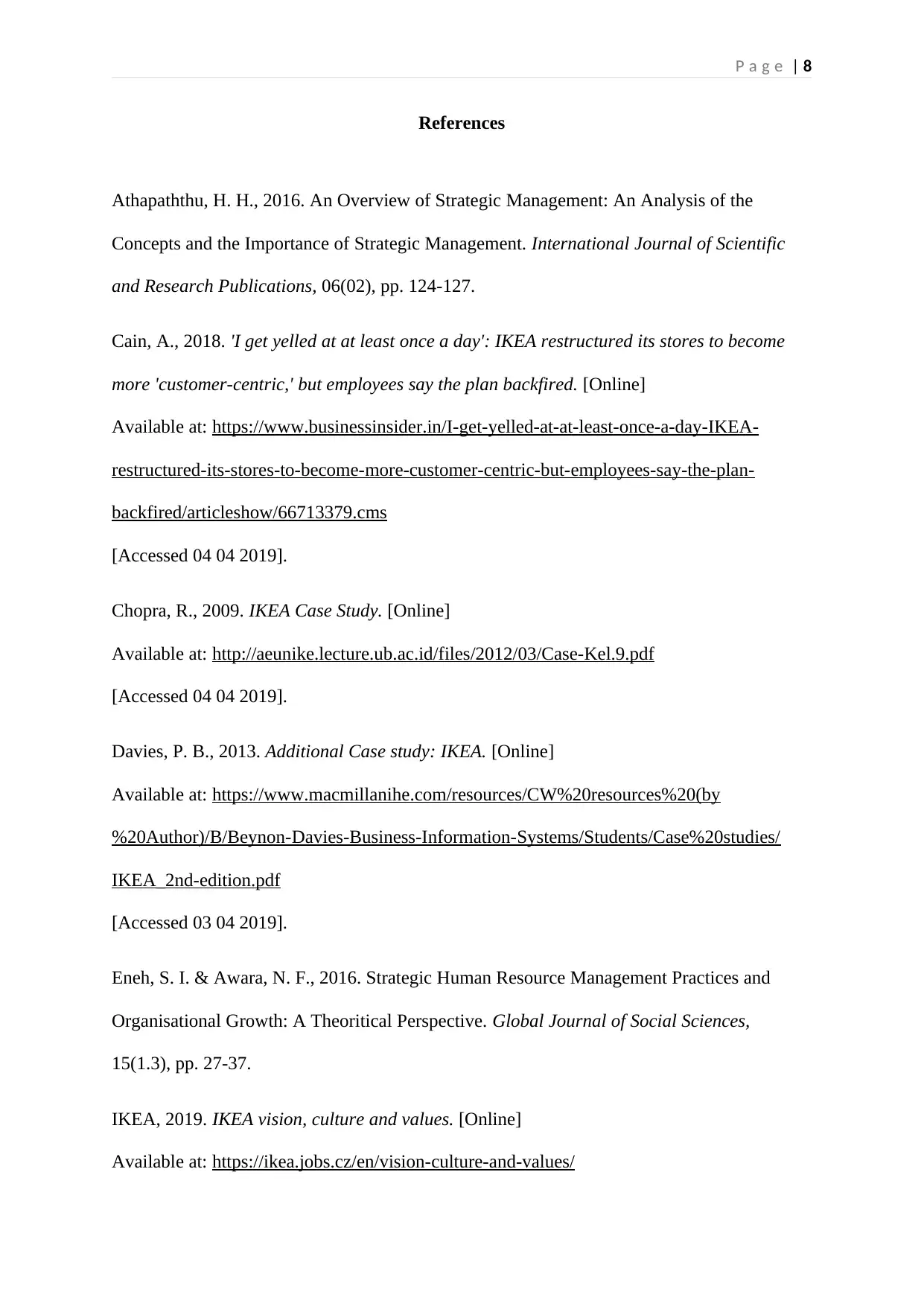
P a g e | 8
References
Athapaththu, H. H., 2016. An Overview of Strategic Management: An Analysis of the
Concepts and the Importance of Strategic Management. International Journal of Scientific
and Research Publications, 06(02), pp. 124-127.
Cain, A., 2018. 'I get yelled at at least once a day': IKEA restructured its stores to become
more 'customer-centric,' but employees say the plan backfired. [Online]
Available at: https://www.businessinsider.in/I-get-yelled-at-at-least-once-a-day-IKEA-
restructured-its-stores-to-become-more-customer-centric-but-employees-say-the-plan-
backfired/articleshow/66713379.cms
[Accessed 04 04 2019].
Chopra, R., 2009. IKEA Case Study. [Online]
Available at: http://aeunike.lecture.ub.ac.id/files/2012/03/Case-Kel.9.pdf
[Accessed 04 04 2019].
Davies, P. B., 2013. Additional Case study: IKEA. [Online]
Available at: https://www.macmillanihe.com/resources/CW%20resources%20(by
%20Author)/B/Beynon-Davies-Business-Information-Systems/Students/Case%20studies/
IKEA_2nd-edition.pdf
[Accessed 03 04 2019].
Eneh, S. I. & Awara, N. F., 2016. Strategic Human Resource Management Practices and
Organisational Growth: A Theoritical Perspective. Global Journal of Social Sciences,
15(1.3), pp. 27-37.
IKEA, 2019. IKEA vision, culture and values. [Online]
Available at: https://ikea.jobs.cz/en/vision-culture-and-values/
References
Athapaththu, H. H., 2016. An Overview of Strategic Management: An Analysis of the
Concepts and the Importance of Strategic Management. International Journal of Scientific
and Research Publications, 06(02), pp. 124-127.
Cain, A., 2018. 'I get yelled at at least once a day': IKEA restructured its stores to become
more 'customer-centric,' but employees say the plan backfired. [Online]
Available at: https://www.businessinsider.in/I-get-yelled-at-at-least-once-a-day-IKEA-
restructured-its-stores-to-become-more-customer-centric-but-employees-say-the-plan-
backfired/articleshow/66713379.cms
[Accessed 04 04 2019].
Chopra, R., 2009. IKEA Case Study. [Online]
Available at: http://aeunike.lecture.ub.ac.id/files/2012/03/Case-Kel.9.pdf
[Accessed 04 04 2019].
Davies, P. B., 2013. Additional Case study: IKEA. [Online]
Available at: https://www.macmillanihe.com/resources/CW%20resources%20(by
%20Author)/B/Beynon-Davies-Business-Information-Systems/Students/Case%20studies/
IKEA_2nd-edition.pdf
[Accessed 03 04 2019].
Eneh, S. I. & Awara, N. F., 2016. Strategic Human Resource Management Practices and
Organisational Growth: A Theoritical Perspective. Global Journal of Social Sciences,
15(1.3), pp. 27-37.
IKEA, 2019. IKEA vision, culture and values. [Online]
Available at: https://ikea.jobs.cz/en/vision-culture-and-values/
⊘ This is a preview!⊘
Do you want full access?
Subscribe today to unlock all pages.

Trusted by 1+ million students worldwide

P a g e | 9
[Accessed 03 04 2019].
Kinyuira, D., 2014. Effects of Porter’s Generic Competitive Strategies on the Performance of
Savings and Credit Cooperatives (Saccos) in Murang’a County, Kenya. Journal of Business
and Management , 16(06), pp. 93-105.
Pelser, T., 2014. The Influence of Technology Strategies and their Link to Company
Performance. Mediterranean Journal of Social Sciences , 05(09), pp. 238-247.
Schneider, F., 2015. IKEA SWOT analysis, strategy and structure. [Online]
Available at:
https://www.academia.edu/11764187/IKEA_SWOT_analysis_strategy_and_structure
[Accessed 04 04 2019].
Simatupang, T. M., Piboonrungroj, P. & Williams, S. J., 2017. The emergence of value chain
thinking. International Journal of Value Chain Management, 8(01), pp. 1-18.
Soliman, H. S., 2011. Customer Relationship Management and Its Relationship to the
Marketing Performance. International Journal of Business and Social Science , 02(10), pp.
166-182.
Tapera, J., 2014. The Importance of Strategic Management to Business Organizations.
Research Journal of Social Sciences and Management, 03(11), pp. 122-131.
[Accessed 03 04 2019].
Kinyuira, D., 2014. Effects of Porter’s Generic Competitive Strategies on the Performance of
Savings and Credit Cooperatives (Saccos) in Murang’a County, Kenya. Journal of Business
and Management , 16(06), pp. 93-105.
Pelser, T., 2014. The Influence of Technology Strategies and their Link to Company
Performance. Mediterranean Journal of Social Sciences , 05(09), pp. 238-247.
Schneider, F., 2015. IKEA SWOT analysis, strategy and structure. [Online]
Available at:
https://www.academia.edu/11764187/IKEA_SWOT_analysis_strategy_and_structure
[Accessed 04 04 2019].
Simatupang, T. M., Piboonrungroj, P. & Williams, S. J., 2017. The emergence of value chain
thinking. International Journal of Value Chain Management, 8(01), pp. 1-18.
Soliman, H. S., 2011. Customer Relationship Management and Its Relationship to the
Marketing Performance. International Journal of Business and Social Science , 02(10), pp.
166-182.
Tapera, J., 2014. The Importance of Strategic Management to Business Organizations.
Research Journal of Social Sciences and Management, 03(11), pp. 122-131.
1 out of 10
Related Documents
Your All-in-One AI-Powered Toolkit for Academic Success.
+13062052269
info@desklib.com
Available 24*7 on WhatsApp / Email
![[object Object]](/_next/static/media/star-bottom.7253800d.svg)
Unlock your academic potential
Copyright © 2020–2025 A2Z Services. All Rights Reserved. Developed and managed by ZUCOL.




